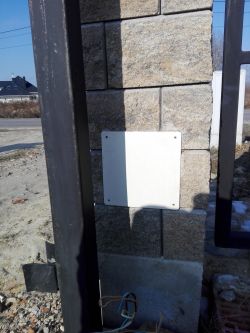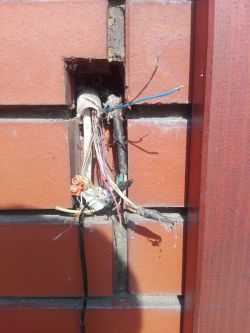ekmir wrote: YTDY 8 x 0.5 - cable routed from the electrical board to the place where the intercom monitor is to be located on the ground floor, and from this point to the first floor.
If this is the only cable we have at our disposal and the monitors cannot be powered, e.g. locally, then for a classic four-wire system it is a bit weak, because 4 wires are the communication bus (audio, ground, video power), two power supplies (provided that both monitors are powered from a common power supply (you may need to replace the original one with a slightly larger one (it's good to take into account the voltage drops when selecting it) and two wires are left for gate control. I would just give two bell buttons (monostable) located next to the monitor or mounted / attached to in it, controlling two relays located, for example, in the electrical switchboard (using the mass of the video intercom). And that's the end of the wires. Unfortunately, we will not have enough for an indicator of opening the gate or wicket. ) we are not always sure if the gate is closed at the moment.
It is also certain that the commax type system is out of the question, where additional wires are needed for the intercom between monitors. So much for what is inside.
Outside, I would lead two strands (of course, earth gel-coated 4X2X 0.5 mm). One can be led directly to the video intercom panel, and the other to the first drive of the gate and from there to the second. I would also give a connector (twisted pair again) between the drive of the first gate and the video intercom panel.
We have some cables piled up under the video intercom panel

from the house, from the gate drive, from the striker, or from some combination lock or exit button. While it does not matter in the case of a metal post, in a brick post it is not always easy and reliable to connect so many cables under the panel. Therefore, in such situations, it is worth providing, for example, a recessed box in the wicket post from the inside. We run cables from the house and, for example, from the drive to it, and then from there to the door panel, catch and other accessories. (at the construction stage, a 20 mm hard conduit with a remote control is enough). We can also lead both cables (twisted pair from the house) to it and leave it with cable / cables to gate drives.
Enclosed are examples of such boxes, as well as an example of connecting cables under the panel (not mine

), where the connection itself is not always too elegant, and then it is not always easy to screw the panel itself on.
Since you are at the stage of building a fence, make sure at this stage:
wicket on adjustable (screw) hinges, the anchor of the catch and installed in such a way that this catch can be replaced in the future, handles instead of handles) Modifications at a later time can be expensive and not always aesthetic and fully functional.
This does not exhaust the topic, but I hope it brings it closer.







